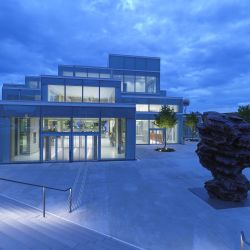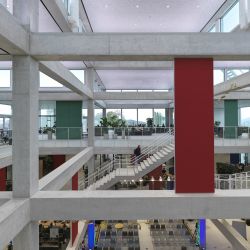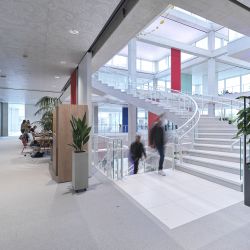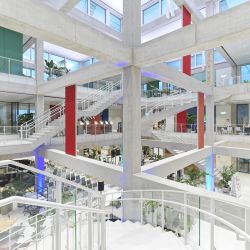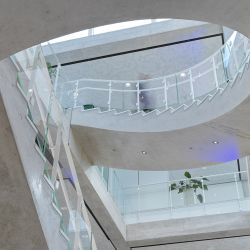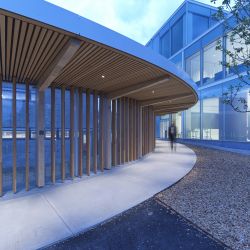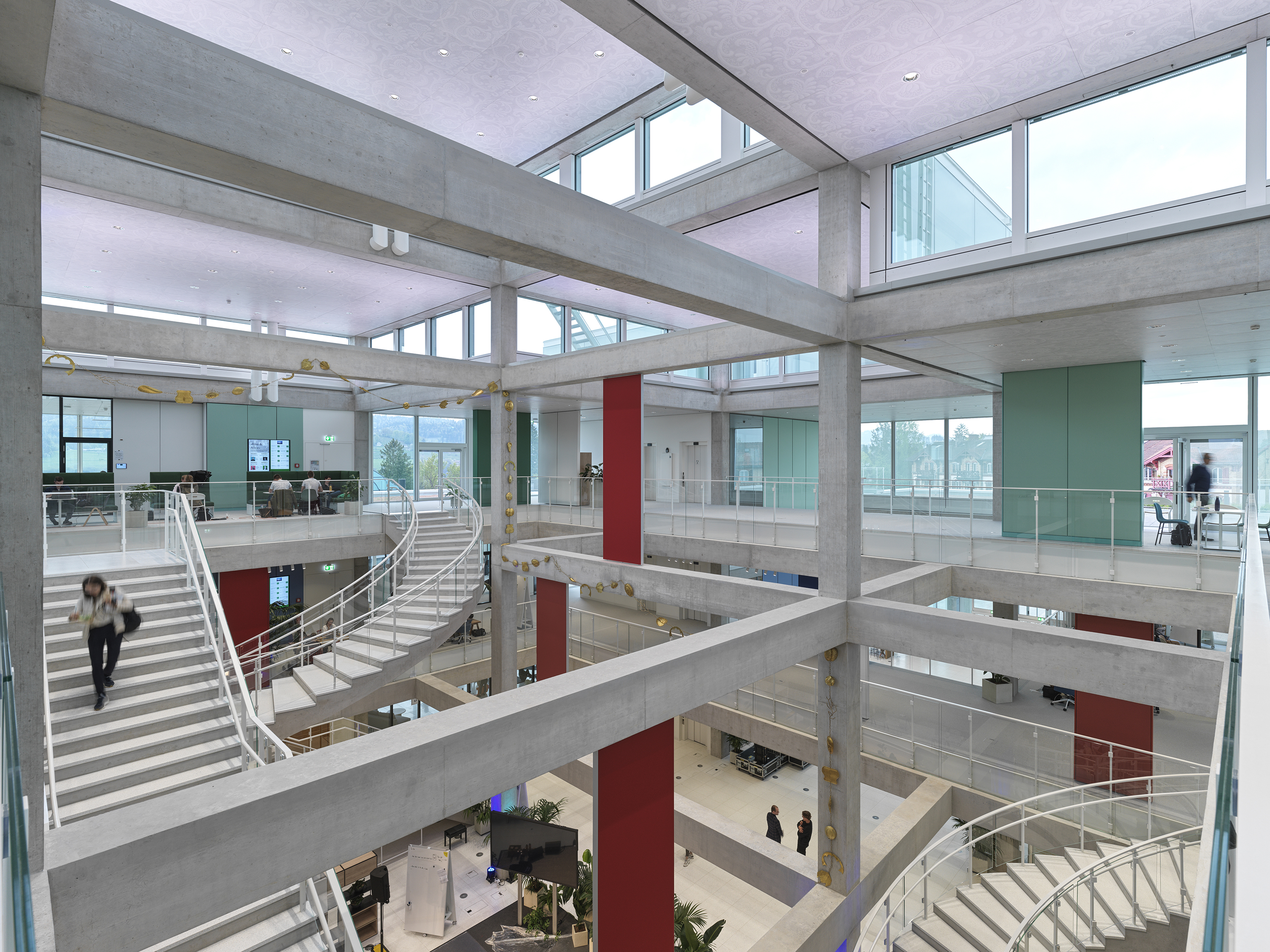
Download this article:
With SQUARE, the University of St. Gallen aims to reshape the future of teaching and learning. The glass and concrete building designed by Japanese architect Sou Fujimoto and inaugurated in the 2022 summer semester adds a location for encounter and dialogue to the university campus – between former students, students and teachers and between the public realm and the university. Transparency, flexibility and high sustainability standards characterise the architecture. Effective lighting with ERCO LED downlights and recessed spotlights complements the sophisticated planning concept and is inherent to the high claim for sustainability.
The Japanese architect Sou Fujimoto operates planning offices in Tokyo and Paris. His designs focus on the integration of natural and architectural elements and are characterised by a strong sense of place. The natural periphery is always part of the spatial experience in Fujimoto's buildings. As is the case with SQUARE, the new building for the campus of the University of St. Gallen – a total of 92 terraced, glazed cubes arranged according to a 10 x 10 metre grid form the new Learning Centre whilst referencing the surrounding hilly landscape. Glass facades link all interior spaces to the outside. Fujimoto's design meets today's high sustainability standards in terms of energy supply and consumption: energy requirements are low due to good thermal insulation, which is covered by a heating and cooling system using geothermal energy and solar panels. In this way, the modern university construction becomes a low-energy building.
Open space instead of closed lecture hall
According to an "open grid" concept, Sou Fujimoto designed a forward-looking spatial concept beyond standardised learning environments and segregated workspaces. This corresponds to the didactic concept of the HSG for the new Learning Center in which teaching is to take place more as a plenary discussion, in communication and in open exchange, rather than in the form of traditional lectures. Akin to this idea, the openly designed spatial landscape promotes interaction and visual references between the different levels and open galleries which are accessed via spiral staircases. This, however, posed certain challenges for the lighting concept: the lighting had to contribute to a maximum flexible utilisation of space. It should provide the highest quality of light, also blend with the architecture and integrate seamlessly. And, last but not least, comply with the high demand for sustainability.
Light suitable for maximally flexible use of space
For the open-room landscape, planar general lighting was specified that features extremely high visual comfort. "The consistently glare-free, and, as far as possible, highly uniform illumination of the interiors with 500lux supports the idea of maximally flexible use of space," explains lighting designer Linda Bohorc.
To underline the impression of the lightness and transparency of the architecture, the architects used concrete with a high white cement percentage. The interiors of the Learning Center also appear light and white, with just a few colour accents in primary colours. Quintessence downlights with wide flood distribution (approx. 50°) were matched to this colour selection with special colour RAL 9010 pure white as part of the ERCO individual service. They provide task lighting with good glare control in areas with single room height. Atrium double focus downlights, which are particularly suitable for use in high rooms with their higher output and flood distribution (approx. 30°), provide general lighting in the double storey areas. Their mounting rings were also customised in special colour RAL 9010 pure white as part of the ERCO individual service. "All downlights thus come with a uniform look," explains lighting designer Linda Bohorc. "For observers these are visually indistinguishable, and are perceived as an integral part of the architecture." In the soffit of the spiral staircases that connect the different levels, cardanically adjustable Gimbal recessed spotlights in special colour RAL 7044 matt grey were installed, matching the colour tone of the exposed concrete in this area. The spotlights with concrete mounting enclosures were installed in a smaller than standard version to avoid any build-up of heat. 4000K was specified as the light colour for all luminaires, indoors and outdoors. This corresponds, on the one hand, to the campus colour neutral white, and on the other, supports the desired uniform lighting effect in Sou Fujimoto's white cuboid building.
ERCO Greenology: sustainable lighting for a future-oriented building
Sustainability and energy efficiency aspects played a role not only in the construction. Illumination of the SQUARE also had to meet the Minergie standard, a Swiss construction standard for new and upgraded buildings. Minergie buildings are characterised by very low energy requirements. The lighting concept for the interiors of the SQUARE is sustainable because it is effective. Dedicated, precise optical systems and perfect lighting technology in ERCO LEDs ensure glare-free lighting. The light is only used where it is needed, for reading, learning and concentrated working together. The concept supports person-to-person communication by achieving harmonious lighting ratios on faces – lighting design according to the principles of Human Centric Lighting.
This effective lighting with energy-efficient luminaires (in terms of lm/W) as well as their consistent focus on human perception leads to improvements in the ecological footprint of a sustainable building. The SQUARE sets standards in architecture and lighting design for the future of collaborative teaching and learning.
For more information and aspects of sustainable lighting, visit www.erco.com/greenology
Project data
Client: HSG Foundation, St. Gallen / Switzerland
Architecture: Sou Fujimoto Architects, Atelier Paris / France Burckhardt+Partner, Switzerland
Lighting design: li.li. Licht GmbH, Winterthur / Switzerland
Photography: Moritz Hillebrand, Zurich / Switzerland
Products: Atrium, Gimbal, Quintessence, Starpoint
Photo credits: © ERCO GmbH, www.erco.com, Photography: Moritz Hillebrand
About ERCO
The ERCO Light Factory in the German town of Lüdenscheid is a leading international specialist in architectural lighting using LED technology. The family business, founded in 1934, now operates as a global player with independent sales organisations and partners in 55 countries worldwide. Since 2015, ERCO’s portfolio has been 100% LED. With this in mind, ERCO in Lüdenscheid develops, designs and produces digital luminaires with focus on photometrics, electronics and design. Working closely with architects, lighting designers and engineers, ERCO develops lighting tools used primarily for applications in the following fields: Work and Culture, Community and Public/Outdoor, Contemplation, Living, Shop and Hospitality. ERCO understands digital light as the fourth dimension of architecture – providing highly precise and efficient lighting solutions to support creative designers in turning their visions into reality.
If you require any further information on ERCO or image material, please visit us at press.erco.com/en. We can also provide you with material on projects worldwide for your media coverage.
Relevant image material
© ERCO GmbH, www.erco.com, Photografie: Moritz Hillebrand
© ERCO GmbH, www.erco.com, Photografie: Moritz Hillebrand
© ERCO GmbH, www.erco.com, Photografie: Moritz Hillebrand
© ERCO GmbH, www.erco.com, Photografie: Moritz Hillebrand
© ERCO GmbH, www.erco.com, Photografie: Moritz Hillebrand
© ERCO GmbH, www.erco.com, Photografie: Moritz Hillebrand
© ERCO GmbH, www.erco.com, Photografie: Moritz Hillebrand
© ERCO GmbH, www.erco.com, Photografie: Moritz Hillebrand
